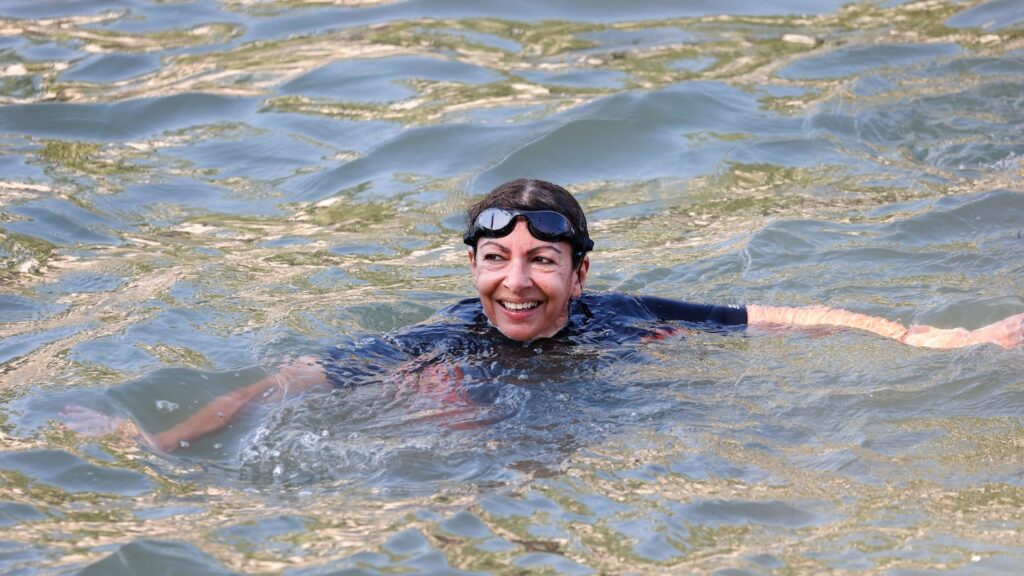“I'm just happy,” Hidalgo said after emerging from the water, fulfilling a vow to swim in the Seine before the Olympics start in nine days.
Wednesday's drop in water levels marked what French authorities hope will be an end to a long-standing and tense situation. Swimming in the Seine has been banned for a century, mainly due to health concerns from sewage that sometimes leaks into the river from the city's old sewers. In 2015, Hidalgo surprisingly unveiled audacious plans to make the river the centerpiece of the Olympics, announcing plans to hold the opening ceremonies and swimming events in the river.
But despite a $1.5 billion investment, bacteria levels have long remained above safety standards, forcing the cancellation of the swimming portion of the Paralympic triathlon competitions and last summer's Open Water Swimming World Cup. This year, environmental group Surfrider Foundation reported “alarming” contamination, with testing at one location over a six-month period finding bacteria above recommended levels of E. coli and Enterococcus faecalis. The swim, promised by the mayor of Paris, has been postponed multiple times for reasons ranging from excessive rainfall to, more recently, political unrest in France.
As recently as last month, the ambitious project was in danger of becoming an embarrassment, with officials discussing alternative plans for the highly anticipated Seine race for the first time. But gloom has given way to renewed enthusiasm in recent days, as the weather has improved this month and the Seine's water quality reached safe standards on most days, according to city measurements.
On Saturday, France's Sports Minister Amélie Oudéa-Castellas became the first French government official to conquer the Seine. She rushed into the river as President Emmanuel Macron's government was on the brink of resigning following defeat in this month's general election. Her swim, which appeared to preempt Hidalgo's plunge, didn't go entirely to plan. In scenes captured on television, Oudéa-Castellas slipped on the riverbank and slid into the water.
President Macron also vowed to swim the Seine earlier this year but did not take part.
Meanwhile, Mayor Hidalgo, whose leftist Socialist party has been gaining momentum since the election, hosted a tightly choreographed event on Wednesday, with organizers setting up a makeshift pier and so many reporters that some had to follow the mayor's descent from outside the security line.
“Now we are ready for the Olympics,” Tony Estanguet, president of the Paris 2024 organising committee, said after entering the water accompanied by Hidalgo and regional secretary Marc Guillaume.
There's no guarantee the Seine will be as clear in two weeks' time, but the weather looks good for the next few days.
But high flows on the Seine continue to cause concern after heavy rains earlier this summer caused river levels to rise to unusual levels for this time of year, and if river levels do not subside over the next nine days, organizers may be forced to change plans for a water parade at the opening ceremony on July 26.
Despite those lingering questions, residents who watched Wednesday's swim said they are excited about the Olympics.
“There's a lot of criticism of the Olympics,” said Margaux Tellier, 34. But being able to swim in the Seine “will raise awareness of the environment and climate change,” she said.
As Paris' heatwave worsens, French authorities want to open river-fed swimming pools along the Seine for Parisians and tourists, including near the Louvre and Notre Dame Cathedral and other disadvantaged areas.
“It would be great if all Parisians had space to swim,” Tellier said.
Swimming events were held in the Seine when Paris hosted the first Olympic Games in 1900, but industrialization caused the river's pollution levels to rapidly deteriorate, and public swimming was officially banned in 1923.
In the 1990s, then-mayor Jacques Chirac vowed to clean up the river and even threatened to jump in himself, but never got around to it. But the attention and influx of money that came with the Olympics accelerated the plan, and officials welcomed it as a way for Parisians to reconnect with their city and the river.
The plan relies in part on a new reservoir to prevent sewage from overflowing into the Seine, and an upstream water treatment plant, both of which only recently opened. The new reservoir can collect the equivalent of 20 Olympic-sized swimming pools' worth of excess storm and wastewater during heavy rains, reducing the risk of overwhelming the city's aging sewer system.
“I was a little nervous,” city employee Matisse Joubert, 24, said before jumping into the Seine on Wednesday. Growing up in Paris, images of the river's foul smell had long overshadowed plans to clean it up. Three years ago, he couldn't imagine swimming in the river.
But Wednesday's drop was “perfect,” he said.
Ellen Francis contributed to this report.

